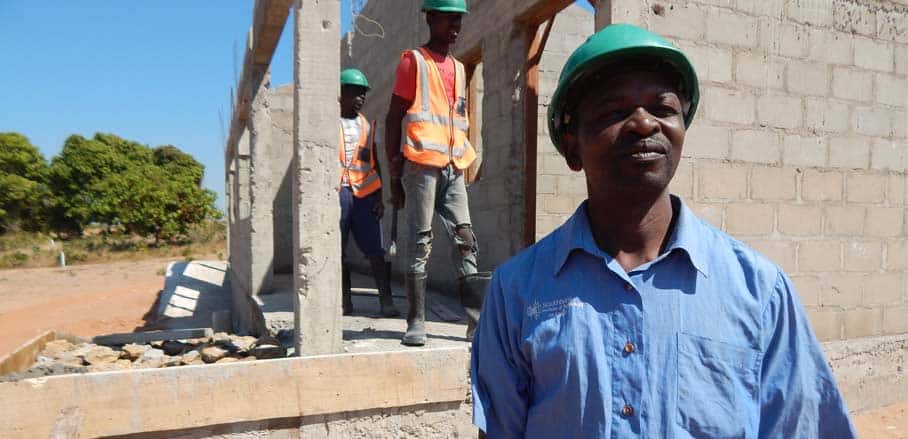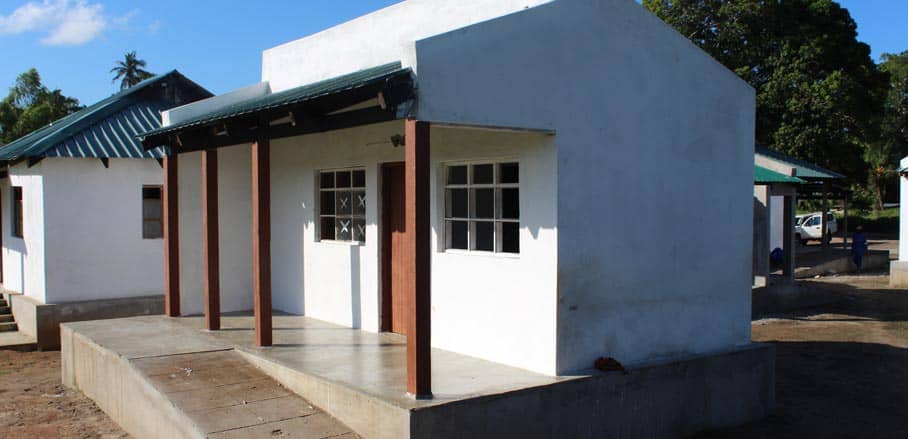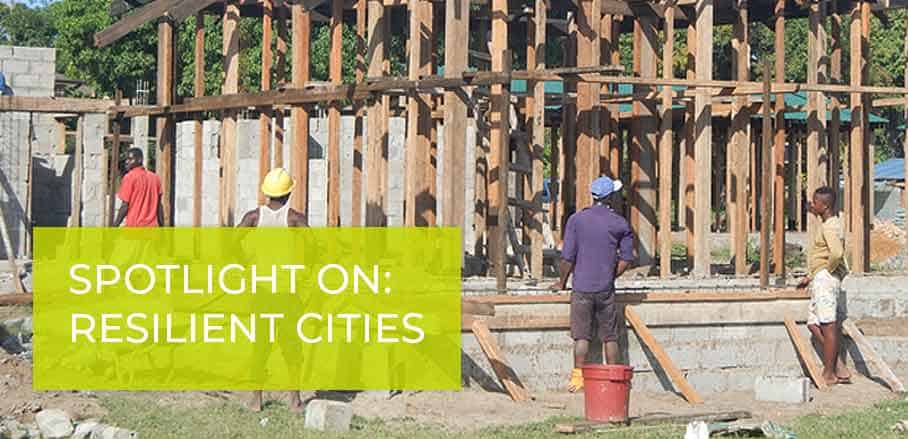Climate-resilient Housing in Mozambique’s Coastal Cities
By Casimiro António, Brian App & Maria Olanda Bata
Constructing a house is a rite of passage to adulthood in most peri-urban areas of Mozambique. While it is common for people to build their own homes using traditional techniques, it often reproduces vulnerability as most of these self-built houses are easily damaged even by low or medium magnitude weather events. How can resilient construction techniques prompt behaviour change in house construction and generate income?
Impacts of Climate Change in Mozambique
Sixty per cent of Mozambique’s 28 million people live in low-lying coastal areas, where sea-level rise and frequent intense storms cause flooding, erosion, and landslides, threatening communities, homes, and businesses. Although coastal cities are the country’s major population centres and the key drivers of economic growth, city planners frequently lack the technical skills to promote urban adaptation to severe weather events. Compounding this problem, city residents regularly build houses and infrastructure wherever they can find available land, including areas prone to flooding, on unstable slopes, and with contaminated water supplies. Homes are often built with low-quality materials and traditional techniques, which are easily damaged by storms and ultimately contribute to a cycle of vulnerability and poverty.
In 2015, USAID’s Coastal City Adaptation Project (CCAP)[1]For publication: https://blog.usaid.gov/2015/03/a-city-in-need-a-case-study-of-climate-change-adaptation-from-mozambique/ was launched with technical support from the United Nations Human Settlements Program (UN-Habitat)[2]For publication: https://unhabitat.org/. [inlinetweet prefix=”” tweeter=”Urbanet_info” suffix=””]The initiative aims to support local governments and municipal authorities in the cities of Pemba and Quelimane to overcome these challenges by developing climate-resilient techniques for improved home building, designed to withstand intense storms and to provide clean, reliable water supply to their residents.[/inlinetweet] During the model design and development process, women and men from selected neighbourhoods were engaged through a series of community meetings and focus group discussions to review the concept of resilient housing, and share and discuss ideas on housing types, construction material, and potential vulnerabilities such as the location of kitchen and toilet. From the insights gained, the program developed and validated housing models and mainstreamed resilient techniques in the community. The program emphasised the importance of considering resilience throughout the construction process, from foundation to walls to roofing, and ensured that construction materials and techniques were appropriate, social and culturally acceptable, and affordable.
Affordable Solutions to Build Resiliency
The issues of affordability were paramount in the planning of the model houses, and CCAP approached it from multiple angles. During the community meetings in both Pemba and Quelimane, CCAP presented more expensive model houses built with optimal materials, as well as models built with the local materials traditionally used in construction to better elucidate how and when to incorporate the techniques in a range of resource scenarios.
The project worked closely with local artisans, training them through practical learning by doing sessions and step-by-step tutorial videos, to improve adoption of resilient housing techniques and incorporate them into their everyday work using both traditional and improved materials. To further increase affordability, the housing models were designed to allow the local artisans to select and apply specific techniques in one of the three housing components (foundation, walls, and roofing) when it is cost prohibitive to apply them in all three. For example, where wind damage is more of a threat than flooding, the roofing techniques could be applied without the more expensive raised foundation.
Finally, CCAP worked with local governments and city authorities to sensitise community members and other local actors to the idea that although the resilient building materials and techniques may be more expensive in the short term, they could be expected to yield long-term savings through avoiding the costs of frequent rebuilding and property damage. To expand the uptake of resilient construction techniques, CCAP is working with strategic partners such as the Mozambique Ministry of Public Work, Housing and Water resources, the National Directorate of Housing and Urbanisation, the Mozambique National Association of Municipalities (ANAMM), and the private sector, who have the resources and mandate to build robust structures and who can adopt the techniques demonstrated in the resilient housing models in their future construction efforts.
Climate Impacts and the Need for Social Behaviour Change
[inlinetweet prefix=”” tweeter=”Urbanet_info” suffix=””]Constructing a house is a rite of passage to adulthood in most peri-urban areas of Mozambique, and in the absence of options, city residents often build houses and infrastructure wherever they can find land available, including in areas highly vulnerable to intense weather events.[/inlinetweet] Self-constructed homes, however, often have little ability to withstand even minor impacts from weather events. CCAP built a modest number of resilient model homes in key highly visible and vulnerable peri-urban areas to facilitate changing attitudes on what constitutes acceptable housing.
This work is taking place in the context of projected climate related impacts which indicate that temperatures have increased by 0.6°C in the period from 1960 to 2006 (an average of 0.13° per decade), while in the same timeframe the mean annual rainfall decreased at an average of 2.5 mm per decade. More than a change in the average totals, rainy seasons have commenced later (leading to the overall decrease) and dry spells have lasted longer. Since the 1950s, the occurrence of extreme weather events including drought, heavy rainfall, hurricanes, and cyclones has increased.
Concomitant to these events, Mozambique’s 2,700 km of coastline has begun to, and will likely continue to experience rises in sea level. This is affecting low-lying areas characterised by a variety of ecosystems, including estuaries, mangrove forests, dunes, inland lagoons, coastal lakes, reefs, and marine swamps, which represent habitats for a wide range of ecologically important and economically valuable species. Projected sea level rise is anticipated to increase vulnerability to erosion and flooding of already stressed ecosystems and population centres. In freshwater ecosystems, saline intrusion due to sea level rise is leading to losses in fish populations. These predictions call attention to the severity of the situation and demand proactivity at all levels to respond to the impacts of climate change, with the housing component of CCAP constituting one response to climate change predictions in the country.
The work of the program has shown that [inlinetweet prefix=”” tweeter=”” suffix=””]people who continue to construct their own houses can easily adopt simple low-cost techniques to improve housing capacity to deal with intense weather events. For example, houses can mitigate the impacts of frequent flash floods by raising a foundation with compacted soil, stone and cement[/inlinetweet] (see more details below). As an entry point, the model homes help to educate women and men from the community, artisans, and local authorities not only on how to adopt resilient housing techniques, but how improved techniques can avoid the costs of frequent repairs after rainfall or strong winds; prevent people from being displaced after storms; and ultimately help to keep families and communities together.
Moreover, the long-term ability to stay in one place can confer economic benefits with the ability to maintain regular employment, build assets over time, and build strong social ties in the communities. Beyond those building their own homes, people with the resources to contract local professionals can now hire artisans who have been trained by CCAP in resilient construction techniques. These builders can now earn additional money from upgrading existing houses as well as constructing new, more resilient homes. To date, the program has seen interest in preventing housing damage increase, and attitude and behaviour towards resilient construction changing in both Pemba and Quelimane.
Design Elements for Resilient Construction
The key housing design elements CCAP addressed to increase resilience are as follows:
Low-vulnerability site selection
Proper site selection can reduce the potential impact of hazards (e.g. avoiding areas with high exposure to flooding and strong winds, and selecting sites with a maximum slope of 45o). It can also avoid social conflict between old and new residents, treat ecosystems as an interconnected element of the site, and promote health, sanitation and environmental protection. CCAP works with municipal cadaster units to build the capacity of staff and systems to properly identify risks and allocate plots for construction, as well as to improve municipal regulations and guidance on site selection.
Raised foundation
The foundations must be built with material that supports the weight of the house and withstands storm-force rain. It should be on an elevated platform above the maximum level of flooding and constructed using conventional or mixed materials such as cement bricks, or reinforced concrete beams. The foundation needs to be filled with compacted soil, at an appropriate depth for local soil characteristics.
Reinforced wall
The walls of the house must be constructed with durable construction material, such as coconut wood, laca-laca[3]Laca-laca – Mozambique local name for small stake ripping., or bamboo wood. They should be reinforced with galvanized wire and diagonal poles (at a 20cm separation) and finished with mortar plaster.
Secure roof with rainwater harvesting capacity
Roofing should be symmetrical (square or rectangular) and constructed with an adequate slope to withstand strong winds (not lower than 12.5°). The roofing materials, including purlin, roof batters, rafters and iron rod, and the roofing sheet, should be properly nailed into the roof supporting beams and tied with galvanized wire.
With increasing potential of water shortage due to climate change, the building is prepared to collect and store as much rainwater as possible. Therefore, the roofing cover sheet must be sufficiently waterproof, constructed with water collection system (gutters and drop tubes) made of suitable PVC and / or aluminium materials, and of a weight that is both resistant to winds and can support the rain harvesting system. Efficient collection and storage of rainwater can help households cope with potential water stress.
The Case for Investment in Resilient Housing
Considering the elements described above, the minimal scenario for building a traditional home employing all of the resilient techniques will amount to about 25% more of the cost of a vernacular house. But besides the construction costs, resilient housing can save numerous associated costs relating to health and loss of time/productivity, to say nothing of the potential loss of life or possible displacement from a destroyed home, and/or the risks of using water from a contaminated source. While models vary, the costs of a resilient home using all the techniques with the optimal materials is not expected to surpass the cost of comparable government and private sector housing currently being built. By demonstrating the techniques of resilient construction, USAID is helping Mozambicans to adapt to the impacts of climate change.
Resilient Construction Techniques Generate Jobs in Pemba City
The province of Cabo Delgado, including its capital coastal city of Pemba, is highly vulnerable to climate change impacts. The oldest city neighbourhood, Paquitequete, is one of the most populated in the entire municipality and subject to the impacts of frequent winds, inundations from rainfall and tides that often cause extensive damage to the community and compromise the normal functioning of social and economic infrastructures. Schools, health facilities, and other basic services providers are often out of commission due to damages caused by these events, with long-term impacts on the development of the community and its residents, forcing the interruption of their day-to-day activities and or relocation to temporary shelters.
Most of the houses in peri-urban Pemba, similar to the neighbourhood of Paquitequete, are built with vernacular techniques using low-quality materials. This makes them easily damaged by storms and contributes to a cycle of vulnerability and poverty. The CCAP project, however, is working with the municipalities and communities to change this scenario. With the advent of the initiative, a group of local artisans from Pemba city are now equipped to build resilient houses and are expanding the opportunities for their businesses.
One of the beneficiaries of the construction techniques is 49-year-old Anrame Cipar[4]Anrame Cipar is an artisan since the year of 2000. Currently he lost the count of the number of housing projects he has been involved since he embraced this profession., an artisan with more than 15 years of professional experience, father of 10 children and the only breadwinner in the family. After learning the techniques in building resilient houses, he has observed an increase in the demand for his services. “I acquired the new techniques when the resilient houses initiative started in December 2015. I went for training and returned to apply what I had learned; and there is a big difference between the techniques I applied before and the ones I apply now. One of them is the use of diagonal poles when we are building houses made of local material”, says Mr Cipar.

Anrame Cipar in front of one of the resilient house that he contributed in the building process. Photo by Leoviildo Nhampule, CCAP, 2018
According to Mr Cipar, the new techniques enabled him to diversify his sources of income and he is presently better able to support his family. “Since I acquired these techniques, I am also working on my own projects now, including a water tank and protection wall. To build the water tank I used mixed material and diagonals to make it stronger so that it could hold the lid and last longer. The additional income I receive as a result of jobs that I managed to attract since I was trained helps me look after my entire family, paying the school fees and meeting the basic house needs comfortably ”, he says. “My next ambition is to be selected to build a house as a master builder where I will have a team of my own to teach and share the techniques in the same way that I was taught while involved in this project”.
Similar to Mr Cipar, there are dozens of other artisans and technicians who benefited from the training and now are qualified to execute similar projects in the cities of Pemba and Quelimane. The beneficiaries participated in workshops that included dialogue, demonstrations, and the step-by-step construction process from foundation to roofing, which allows for dramatically improving the houses’ resilience to climate change.

Finished houses ready to be visited by community members for replication of the techniques. Photo by Sergio Pedro, CCAP, 2018
Conclusion
With a variety of options in the application of techniques and materials, resilient housing can be made affordable and appropriate both for resource-poor rural populations who are building their first home and private sector industries constructing upscale staff housing. By improving the resiliency of homes, especially those in areas prone to disastrous weather and climate events, USAID is not only supporting Mozambicans to adapt to the impacts of climate change. They also contribute to the overall development of the country.
